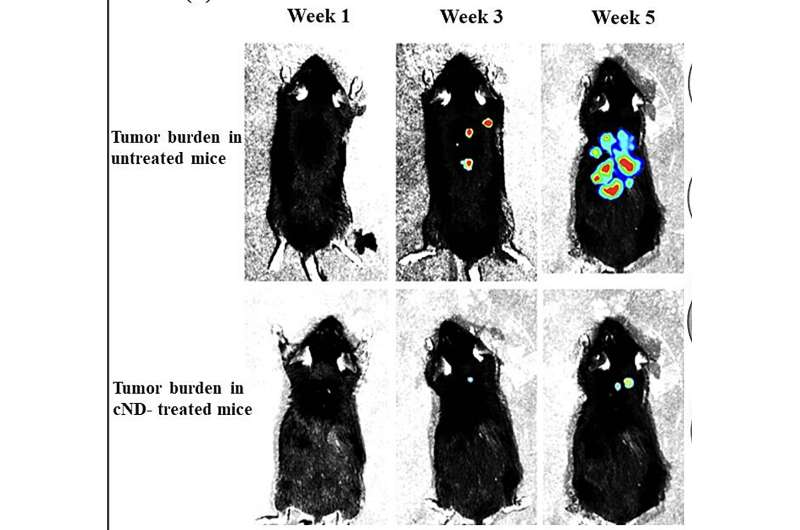
Nanodiamonds are 2–8 nm carbon nanoparticles, which can be easily functionalized with various chemical groups like carboxylic groups or drugs. Previous research has shown that actively dividing cells are more likely to absorb nanodiamonds and that epithelial cells treated with carboxylic nanodiamonds lose the ability to migrate across cell-permeable cellulose membranes.
Rajiv K. Saxena and colleagues explored whether nanodiamonds might block tumor metastasis, a process that requires cell migration to new areas. The research is published in the journal PNAS Nexus.
The authors treated B16F10 melanoma cells with carboxylic nanodiamonds in culture and tested their ability to migrate and invade across polycarbonate membranes with 8-µm pores. The authors found that the nanodiamonds blocked the ability of melanoma cells to migrate, while untreated tumor cells were able to pass through the membrane.
Mice (C57Bl/6) administered B16F10 melanoma tumor cells and then treated with carboxylic nanodiamonds showed little or no metastasis of tumors, while untreated mice saw their tumors grow and move to new areas of the body.
Survival of the tumor-bearing mice treated with carboxylic nanodiamonds was also significantly better than untreated tumor-bearing mice.
Based on gene expression evidence, the authors hypothesize that the tiny carbon nanodiamonds may inhibit the breaking away of cancer cells from the primary tumor mass—as well as block subsequent steps of metastasis such as the physical movement of cells and their ability to enter blood vessels.
According to the authors, nanodiamonds should be further explored as a possible therapeutic agent for cancer metastasis.
More information:
Sushreesangita P Behera et al, Carboxyl nanodiamonds inhibit melanoma tumor metastases by blocking cellular motility and invasiveness, PNAS Nexus (2023). DOI: 10.1093/pnasnexus/pgad359
Journal information:PNAS Nexus
Provided by
PNAS Nexus

READ MORE
Southern Grasshopper mouse: The tiny super-predator that howls at the moon before it kills
The southern grasshopper mouse is largely immune to the venom of the Arizona bark scorpion [...]
Unconventional experiments produce new nanoscale particles with big potential
Hundreds of new nanoparticles, complex materials about the size of a virus, with previously unknown [...]
Why Choose Repetry: The Advantages of Personalized Online Language Tutoring
Repetry’s personalized learning approach is revolutionizing language education. By tailoring lessons to individual needs, students [...]
Biomedical Science Studies Are Shockingly Hard to Reproduce
Seeking transparency in the scientific literature. urfinguss/iStock It’s hard to argue against the power of [...]
Nanopore-based sensing device explores neurodegenerative diseases
This silicon nitride nanopore-based sensing device is providing insight into tau and tubulin protein molecules [...]
Improvements in the material that converts X-rays into light could allow a tenfold signal enhancement
Researchers at MIT have shown how one could improve the efficiency of scintillators by at [...]
Breakthrough in nanostructure technology for real-time color display
Photonic Janus colloids with nanostructured cone l. Credit: ACS Nano (2024). DOI: 10.1021/acsnano.4c00230 A technology [...]
Birds of a feather flocking together: Research shows storks prefer to fly with conspecifics during migration
White stork. Credit: Christian Ziegler With long legs and large wings, the white stork is [...]